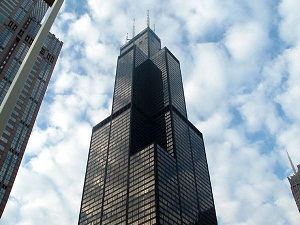Former Sears Tower testing solar window technology
 The tallest and one of the most iconic buildings in the country could soon be generating most of its own energy with high-tech solar photovoltaic windows.
The tallest and one of the most iconic buildings in the country could soon be generating most of its own energy with high-tech solar photovoltaic windows.
The Willis Tower, formerly the Sears Tower, in Chicago now has a 2-square-foot section of windows generating solar energy. The patch is a test ground for Pythagoras Solar’s cutting-edge new technology. If it’s successful, the Willis Tower owners say they will expand the project to cover the entire south face of the tower in the solar windows, said Udi Paret, spokesman for Pythagoras Solar.
He explained the technology.
Each window is a double-paned with solar cells stacked in between. The windows are transparent, so people can still see out, and diffused sunlight can still provide natural lighting inside the building. The windows also contain dozens of tiny, but super efficient solar cells, Paret said.
Because the cells are small, Pythagoras was able to use monocrystalline solar cells with the highest efficiency ratings, Paret said.
While they are featured on a south-facing and immobile structure, they are still about 14.1 percent efficient, Paret said. That’s pretty solid for having a fixed and less than direct angle toward the sun.
“Without losing anything, we’re able to get a lot of energy,” Paret said.
If this small test area is successful, Pathagoras expects to be able to expand the project to cover a whole floor of windows on the south face of the building. If that project succeeds, the company will retrofit all of the windows on the south face with its new solar windows. Pathagoras estimates that converting all of the old windows in the iconic Willis Tower to its solar windows would produce roughly 2 megawatts of solar electricity for the building, according to a press release.
“Of course, the idea then would be to cover three sides, all but the north, in the windows,” Paret said.
He said that shading is an issue and that windows on the lower levels would not likely be as productive as those that are never in the shadow of another building. But Paret said that Willis Tower owners conducted their own shading study and found that there are very few parts of the south side of the building that would not be able to capture solar energy during at least some parts of the day.
Paret said the Pythagoras technology is also advanced enough that each individual cell operates independently and is networked with the others, which differs from most standard photovoltaic panel systems, which are often linked together in a series and can cause each other to fail when there are problems with just one (much like old holiday lights).
Pythagoras, which has existed since 2007, has installed its solar windows on buildings in Israel and China and is working with other building owners in the United States.



